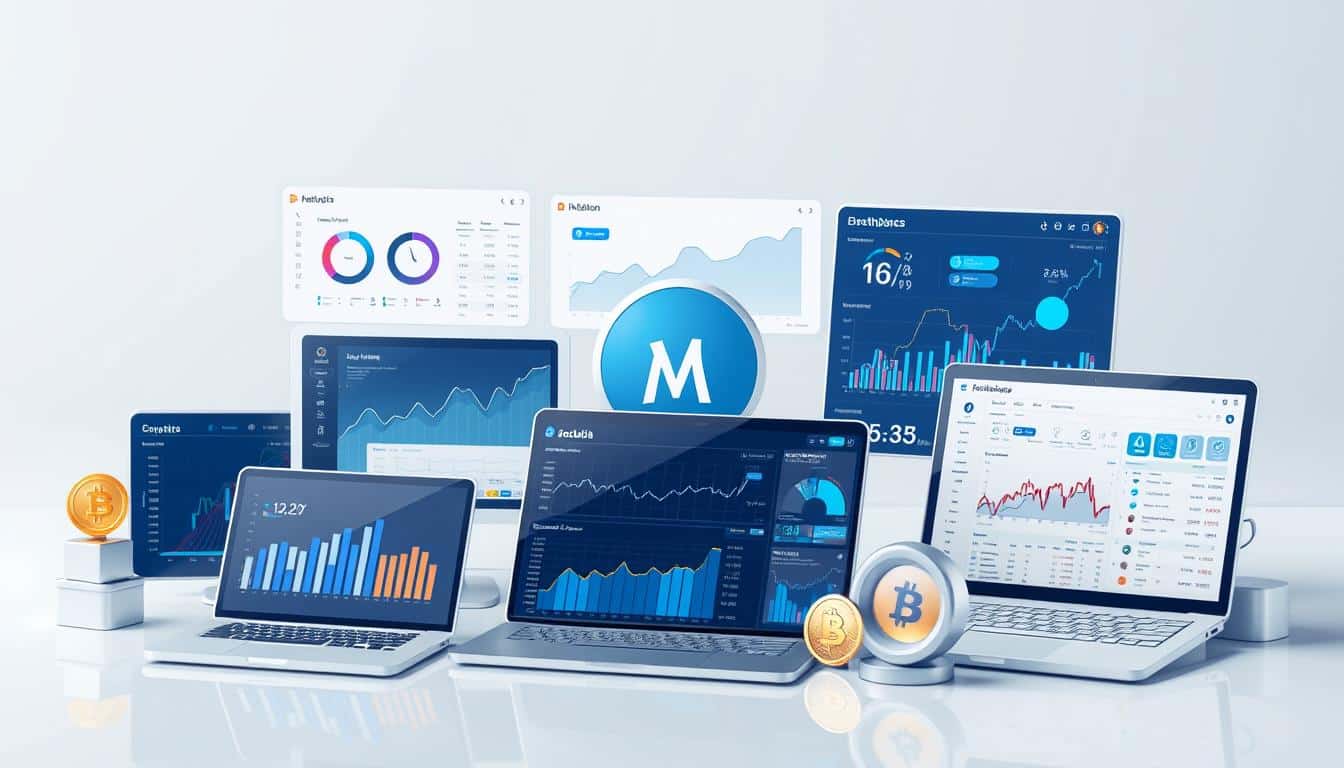Top Blockchain Analytics Tools for Investors
About 2.1% of Bitcoin’s total is owned by governments. The U.S. has around 198,012 BTC, China has about 190,000 BTC, and the U.K. owns near 61,245 BTC. These holdings can sway market liquidity and risk in unexpected ways for everyday investors.
I keep an eye on blockchain movements and follow what the SEC under Gary Gensler does. Actions against big names like Coinbase, Kraken, or Ripple Labs quickly affect the crypto market. That’s why top blockchain analytics tools are crucial for investors. They help you grasp supply concerns, big player movements, and currency flow on exchanges.
In this guide aimed at investors, I’ll review the best blockchain data analytics services. I’ll talk about the tools I often use or try out, like Chainalysis, Glassnode, Dune Analytics, and CryptoQuant. You’ll get useful details on their features, how much they cost, my take on using them, and key stats for investors, whether you’re in it for the long haul or trading actively.
Key Takeaways
- On-chain transparency matters: government holdings and exchange flows can create supply shocks.
- Regulatory scrutiny under Gary Gensler raises the value of compliance-aware analytics.
- Not all platforms are equal — choose tools matched to your strategy (long-term vs. active trading).
- Top blockchain data analytics platforms differ by metrics, customization, and pricing.
- Investor-friendly blockchain analysis tools give actionable signals, not just raw data.
Introduction to Blockchain Analytics
I started exploring on-chain data for better insights than what price charts show. Blockchain analytics involves gathering, processing, and analyzing data from the blockchain. This includes looking at transactions, how wallets interact, miner activities, and other metrics.
What is blockchain analytics? It’s a set of tools and methods that transform raw blockchain info into insights you can use. You can track wallet activities and exchanges through chain explorers and address tagging. APIs let you access data for your own analysis. By clustering wallets and labeling transactions, you uncover hidden relationships.
Advanced tools give investors detailed data like who owns what and the risks involved. These tools mix live and past data to test theories. I use these to focus on what really matters amid all the noise.
Why do investors care? On-chain data can signal upcoming market changes. Things like big investors buying more, sudden funds moving to exchanges, or miners acting oddly can affect prices. Spotting large transactions or funds leaving an exchange gives me a better sense of when to buy or sell.
Regulations are important, too. Gary Gensler wants to make sure investors are protected. This makes analytics tools that keep an eye on rules more valuable. For everyday traders, these tools help avoid risky deals and dubious wallets.
I look for specific things in analytics platforms. They must have up-to-the-minute data, comprehensive historical data, and ways to customize what I see. Getting alerts about big transactions is crucial for me to stay informed.
I also need to know who owns what wallets, how to recognize exchanges, and understand risk levels. Tools like Sankey diagrams and time series charts help make sense of complex data. Being able to access data easily for my own models is a must.
The cost and support materials are also key. Prices and the quality of guides vary widely. I prefer services with clear prices and helpful API documentation.
In summary, tools for analyzing blockchain data are essential. They help me discern useful info from the clutter and base my decisions on solid data.
Overview of the Best Blockchain Analytics Tools
I’ve checked out Chainalysis, Glassnode, Dune Analytics, and CryptoQuant against real work needs. Each one is good for different things: making sure things are legit, research for big money moves, looking into community questions, or hints for trading. I looked at what they cover, who they’re for, how up-to-date they are, how much you can change them, and how they let people work together. This helps you pick the right one for your job.
Comparison of Top Tools
Coverage isn’t the same across the board. Chainalysis goes wide with lots of chains, focusing on big currencies and exchanges. Glassnode digs into Bitcoin and Ethereum. Dune Analytics lets everyone in to use lots of chain data based on what users share. CryptoQuant is all about what’s happening in exchanges and with miners.
The main users of each are quite different. Chainalysis is for people checking rules, regulators, and exchanges. Glassnode is for big-time researchers and investors. Dune Analytics is where analysts and protocol folks go for custom data looks. Traders who want fast, useful numbers go to CryptoQuant.
Data freshness and how much you can make it your own split up naturally. Chainalysis gives super up-to-the-minute feeds for looking into things deeply. Glassnode has up-to-date chain data that’s deep and wide. Dune is great for on-the-fly data pulling and making your own charts. CryptoQuant gives traders quick numbers and flow info.
Being part of a community adds value. Dune wins with a big library of templates and shared projects. Glassnode shares indicators and explains data in blogs. Chainalysis keeps to small groups for rule-checkers. CryptoQuant offers a mix of open and paid data for those making trades.
| Tool | Coverage | Primary Audience | Latency | Customizability | Community Features |
|---|---|---|---|---|---|
| Chainalysis | Multi-chain focus; deep exchange & AML links | Regulators, exchanges, compliance teams | Near real-time for investigations | APIs and enterprise integrations; limited public dashboards | Private client communities and training |
| Glassnode | Strong Bitcoin & Ethereum on-chain coverage | Institutional researchers, investors | High-frequency on-chain updates | Rich charting and indicator presets; scripting for power users | Public indicators, research articles, newsletter |
| Dune Analytics | Flexible per-chain depending on community tables | Developers, protocol analysts, community researchers | Depends on data ingestion; interactive queries | Full SQL dashboards and custom visualizations | Extensive public templates and shared queries |
| CryptoQuant | Exchange flows, miner flows, market metrics | Traders and quant analysts | Near real-time for market signals | Preset dashboards with configurable alerts | Public charts and paid indicator marketplace |
Unique Selling Points
Chainalysis is known for top-notch tracking and clear connections. I count on it for checking rules and origins. It’s a go-to for governments and many exchanges because it scores risks well.
Glassnode is awesome for deep market data showing investor moves. It brings out special supply and cap data for longer looks at the market. I use it to get the big picture.
Dune Analytics is where I go for tailor-made data pulls. It’s perfect for diving into specific protocols or tweaking a shared template. Its approach based on SQL lets you craft new views quickly.
CryptoQuant is all about what traders need to know. It offers direct views on exchanges and miners that help with decision-making and timing trades well.
Pricing Models
Most of these tools use a “try some for free, pay for more” approach. Then they offer levels of paying more for extra data and tools. When big needs or rules come into play, they talk custom prices.
Chainalysis usually aims for big-budget deals for deep dives and data rights. Glassnode and CryptoQuant have clear steps from solo use up to big business levels. Dune offers a lot for free with options to pay for more privacy, fast computing, and team work.
For big Bitcoin checks or reporting by the rules, serious contracts matter. Tools like Chainalysis become crucial for official checks and making sure everything’s correct.
Tool 1: Chainalysis
I’ve worked with Chainalysis for different tasks. It’s great for tough tasks like deep labeling and mapping connections across blockchains. It’s a top choice for investors needing precise blockchain analytics.
Chainalysis offers features like transaction monitoring and KYC/AML tools. It’s trusted by exchanges and law enforcement for tracking funds and following rules. It’s a leading solution for groups needing detailed tracking.
Key features and benefits
- Transaction monitoring: get alerts and trace past transactions for suspicious activity.
- Entity attribution: find out who owns which addresses on the blockchain.
- Risk scoring: use risk scores to focus on the most important cases.
- Investigation tools: see transactions visually, group wallets, and gather data for audits.
- API access: connect to data automatically for custom tools and checks.
User experience and reviews
Users like its accurate data and detailed labeling. It helps sort out complicated transactions faster. Chainalysis helps compliance teams work more efficiently.
However, it can be a bit tricky for smaller traders and investors. It’s not as easy to use as simpler tools, and it can be costly. But for those focused on quality, it’s one of the best options.
Case studies and success stories
Chainalysis has been linked to big enforcement cases. It’s been used to track seized bitcoins and investigate major fraud cases. These actions show its importance in legal and regulatory work.
Exchanges use Chainalysis to keep up with new regulations. It’s an essential tool for staying compliant in the blockchain world.
| Capability | Benefit | Who Gains Most |
|---|---|---|
| Transaction Monitoring | Real-time alerts reduce exposure to illicit flows | Exchanges, custodians, compliance teams |
| Entity Attribution | Clear labels speed investigations and reporting | Investigators, regulators, institutional investors |
| Risk Scoring | Standardized triage for suspicious activity | AML officers, compliance analysts |
| Investigation Workflows | Visual graphs and exports streamline case work | Forensic teams, legal departments |
| API & Integration | Automated checks and custom dashboards | Developers, institutional investors seeking automation |
Tool 2: Glassnode
I’ve used Glassnode for months to keep an eye on blockchain activities and test trading moves. It mixes sleek designs with detailed insights. This makes it great for investors seeking clear, uncluttered data.
Glassnode highlights key on-chain indicators essential for decision making about timing and risk. I depend on a few main metrics to understand the market’s framework and how players act.
Key Features and Metrics
Every day, I check active addresses, exchange balances, and realized cap. These lead to other indicators like SOPR and long-term holder patterns.
The platform also tracks supply changes and net flows, distinguishing big players from average investors.
With an API and charting tools, Glassnode caters to various needs with daily to real-time data. It’s why many traders see it as a go-to for advanced blockchain analysis.
Insightful Graphs and Statistics
Glassnode’s charts help me spot buying and selling trends. I especially look at how accumulation contrasts with distribution.
It also shows miner income, hash rate patterns, and big transactions clearly. Data on government actions like U.S. treasure moves are easy to spot. This makes following story-driven market changes simpler.
Market Predictions and Trends
My predictions often start with Glassnode’s data. For example, dropping exchange reserves usually mean a bullish market is coming. A rise in big player activities or large transactions might mean market shifts.
By testing past events, I sharpen my strategies. Glassnode stands out for its comprehensive historical data, essential for confirming market signals.
Combining Glassnode’s insights with other data sources helps me avoid relying on just one viewpoint. This approach gives me a broader perspective for safer market entries.
Tool 3: Dune Analytics
I began using Dune Analytics for its unique views that other platforms didn’t offer. With Dune, I can use SQL to dig into blockchain data, create dashboards, and see details about DEX volume, liquidity pools, and NFT movements. Its ability to adapt makes it a top choice for active blockchain investors.
Custom Analytics Solutions
I craft SQL queries to select the data I need. This lets me create specific charts for things like token distribution or DEX volume analysis. Dune’s tools help me combine these queries into dashboards that update quickly.
For those who like to do things themselves, Dune is affordable. You can start small and then expand. This has made it a popular tool for analyzing blockchain data.
Community Contributions
The community aspect of Dune is impressive. It boasts thousands of shared dashboards and queries for tracking things like TVL, whale activities, and more. I often use a public dashboard, adjust it to my needs, and base my analysis on that.
The shared resources speed up research. They serve as starting points, saving time. This is a big reason why Dune is high on the list for collaborative blockchain investors.
Real-World Applications
Investors rely on Dune to track protocol-level activities and shifts in DeFi liquidity that might impact token values. I’ve used it to follow token distribution and spot liquidity changes indicating potential risks.
For teams and solo researchers, Dune strikes a balance between capability and cost. It offers in-depth analysis without being too expensive. Thus, it’s a favorite among blockchain data analytics platforms.
Tool 4: CryptoQuant
I started using CryptoQuant to track exchange flows and miner activity. The interface is easy to navigate. It quickly shows when big reserves move and funding rates change. This makes it simple to see short-term changes while keeping an eye on the big picture.
Data Metrics and Dashboards
CryptoQuant looks at exchange ins and outs, miner flows, funding rates, and more. It’s for traders who need early warnings of market moves. You can get alerts for big changes in exchange reserves or sudden increases in liquidations.
Historical Data Analysis
The platform offers strong historical data for testing strategies. I used data on exchange reserves, supply dynamics, and margins. This depth is useful for understanding trends over different periods.
Why it’s a Top Choice for Investors
From my experience, CryptoQuant offers the right mix for traders and investors. It stands out among analytics tools for its quality and affordability. The clear alerts and dashboards make it a great choice for all levels of investors.
For those looking for blockchain analysis tools, CryptoQuant provides useful insights on exchange activity and miner pressures. It’s a great addition to any investment toolkit that includes on-chain data, pricing, and market sentiment.
Statistical Insights from Blockchain Analytics
I’ve been studying blockchain data for years. The numbers might seem dull at first, but they tell a story once you understand them. I’ll share the key metrics I follow, how countries affect the market, and what charts I find useful.
Trends in Investment Returns
Before a price rally, exchange reserves often drop. This happens as balances on centralized exchanges decrease, making liquidity scarcer and reducing selling pressure. Another positive sign is when long-term investors grow. More wallets holding onto their investments for over a year means less supply in the market and a tilt towards steady investment.
It’s also important to look at on-chain activity. More transactions and active addresses indicate growing momentum. Despite markets being driven by excitement, on-chain data can help avoid false alarms. Gary Gensler, a regulatory figure, has pointed this out.
User Growth and Blockchain Adoption Rates
True adoption is seen in the increasing numbers of wallets, mining operations, and government actions. For example, Bhutan has 10,565 BTC, Citadel Mining controls 6,376 BTC in the UAE, and El Salvador buys about one BTC every day, nearing a total of 6,319 BTC.
This accumulation by nations and companies changes the network’s dynamics. Mining at the state level and national investments shift miner motivations and boost investor trust. The adoption by countries shapes the demand on the blockchain and trends in user growth.
Visual Data Representation (Graphs)
I like dashboards that combine different types of graphs. Here’s what I suggest for serious investors.
- Exchange reserve time-series — daily view and 30-day moving average for trend clarity.
- Whale transfer heatmaps — cluster large transfers by size and destination.
- Realized cap vs. market cap — highlights valuation pressure and realized profit/loss.
- SOPR (Spent Output Profit Ratio) — shows distribution of on-chain profits.
- Cumulative BTC held by governments — plot sovereign holdings over time.
To illustrate the impact of government actions, a graph showing the U.S., China, and the U.K.’s BTC holdings as a supply percentage is useful. This clearly shows their effect on market liquidity, with their combined share being about 2.1%.
I rely on leading blockchain analytics platforms like Dune, Glassnode, and Chainalysis for these graphs. They provide the raw data and templates to create clear dashboards that combine different data sources.
I predict more involvement from institutions and governments in the blockchain space. Acts like the BITCOIN Act and public reserve initiatives highlight the need for clear regulatory tools. As a result, the demand for top-notch blockchain analytics tools will increase, especially those offering a seamless mix of compliance features and clean design.
Here’s a quick guide on which visual features are most important for different scenarios.
| Use Case | Key Graphs | Preferred Platform Type |
|---|---|---|
| Active trading & momentum | Exchange reserves, SOPR, realized cap vs. market cap | Top blockchain data analytics platforms with real-time feeds |
| Long-term allocation | Cumulative government holdings, long-term holder accumulation | Best blockchain analytics tools for investors offering on-chain custody views |
| Compliance & institutional reporting | Whale transfer heatmaps, address clustering, provenance traces | Best blockchain data visualization software with audit trails and export |
FAQs about Blockchain Analytics Tools
People often ask me the same practical questions. Here are three essential ones for those starting or upgrading their blockchain analytics tools.
What Should Beginners Know?
Begin with what’s free. Try Dune’s, Glassnode’s limited plans, and CryptoQuant’s trials to learn at no cost. Play around with different dashboards and practice exporting little bits of data.
Know the important indicators like exchange flows, active address numbers, SOPR, and realized cap. Check several metrics to confirm signals. Using just one indicator might mislead, especially with tokens that have low trade volumes.
Start by focusing on Bitcoin and the main tokens since they have more reliable data. Be careful with altcoins. They often depend on hype, which can make their data less trustworthy.
Security and Privacy Concerns
Keep your API keys secure, just like your wallet keys. Put them in a safe place, limit what they can do, and change them regularly. Use different accounts for exploring and for trading.
These platforms collect public blockchain info but often ask for personal details for advanced features. Chainalysis, for example, takes compliance seriously, so be ready for thorough checks and know they keep records.
Be careful when you export data. Don’t put raw keys in places others can see. Check exported files for sensitive info. Always remove personal data before sharing.
How to Choose the Right Tool?
Think about what you need. Do you want tools for checking compliance, finding trading signals, or for in-depth research? Match the tools to your work and your budget.
Search for tools that cover many blockchains, have a long history of data, send alerts, and allow for custom searches. Decide if you prefer the flexibility of SQL or a user-friendly dashboard.
Many experts use several platforms to get a well-rounded view. A common setup includes Glassnode for macro views, Dune for custom queries, and CryptoQuant for trading insights. This way, you can get a fuller picture and avoid missing important details.
| Question | Practical Tip | Why It Helps |
|---|---|---|
| Where to start? | Use free tiers on Dune, Glassnode, CryptoQuant and practice exports. | Low cost learning curve; confirms your workflow before paying. |
| What indicators matter? | Monitor exchange flows, active addresses, SOPR, realized cap. | These metrics highlight liquidity shifts, user activity, and profit-taking. |
| How to protect data? | Secure API keys, enforce least privilege, rotate credentials. | Prevents account compromise and limits exposure if leaks occur. |
| KYC and privacy | Expect KYC for enterprise products; audit data retention policies. | Clarifies compliance needs and operational privacy before onboarding. |
| Choosing a stack | Define use case, then pair tools like Glassnode + Dune + CryptoQuant. | Combines macro, custom analytics, and trader signals from top-rated blockchain analytics solutions. |
| Budgeting | Map features to cost, favor monthly trials then annual plans if useful. | Controls spend and reveals which top blockchain investment analytics platforms deliver real value. |
Conclusion: Maximizing Investment with Analytics
I’ve learned that patterns in data are more important than what the news says. I mix different data types like exchange flows, how long people hold on to their coins, and custom measures. This way, I sort out the important info from the less important. I also set up alerts and look at past data to improve my investment picks. This helps me spot trends that could be just hype, especially if the SEC is talking about them.
Leveraging Data for Investment Decisions
To make smart choices, I layer different types of data. I keep an eye on money moving in and out of exchanges and check if long-term investors are buying more. I also look at specific measures for trading events. Testing these data points with past scenarios helps me be confident before I invest real money. This process turns blockchain data tools into something investors can actually use, not just cool-looking charts.
Future Trends in Blockchain Analytics
As more governments and big players invest in crypto, the need for checking compliance and the source of coins will go up. For example, the U.S. owns roughly 198,012 BTC, and China has about 190,000 BTC. Smaller countries, like Bhutan with 10,565 BTC, are also getting involved. With leaders like Gary Gensler focusing on market risk, there’s more interest in sophisticated data analysis. We’ll see tools offering better tracking, compliance checks, and wider use by big organizations and countries.
Final Recommendations for Investors
Beginners should start with either free or cheap plans from places like Dune Analytics or Glassnode. Move on to more expensive options when you need deeper insights. Chainalysis is great for dealing with legal rules or looking into the details of transactions. However, remember these tools help but don’t guarantee success. Mix this data with wider market, legal, and other types of research. Keep an eye on cryptocurrency news, like government investments or actions by the SEC, to make strong, flexible investment plans.







 Bitcoin
Bitcoin  Ethereum
Ethereum  Tether
Tether  XRP
XRP  USDC
USDC  Lido Staked Ether
Lido Staked Ether  TRON
TRON  Dogecoin
Dogecoin  Cardano
Cardano  Figure Heloc
Figure Heloc  WhiteBIT Coin
WhiteBIT Coin  Wrapped stETH
Wrapped stETH  Bitcoin Cash
Bitcoin Cash  Wrapped Bitcoin
Wrapped Bitcoin  USDS
USDS  Chainlink
Chainlink  Wrapped eETH
Wrapped eETH  Binance Bridged USDT (BNB Smart Chain)
Binance Bridged USDT (BNB Smart Chain)  LEO Token
LEO Token  Hyperliquid
Hyperliquid  WETH
WETH  Stellar
Stellar  Zcash
Zcash  Monero
Monero  Ethena USDe
Ethena USDe  Coinbase Wrapped BTC
Coinbase Wrapped BTC  Litecoin
Litecoin  Sui
Sui  Avalanche
Avalanche  Hedera
Hedera  Shiba Inu
Shiba Inu  sUSDS
sUSDS  USDT0
USDT0  Dai
Dai  Mantle
Mantle  Toncoin
Toncoin  World Liberty Financial
World Liberty Financial  PayPal USD
PayPal USD  Cronos
Cronos  Ethena Staked USDe
Ethena Staked USDe  Uniswap
Uniswap  Polkadot
Polkadot  Aave
Aave  Bittensor
Bittensor  USD1
USD1  MemeCore
MemeCore  Canton
Canton  Bitget Token
Bitget Token